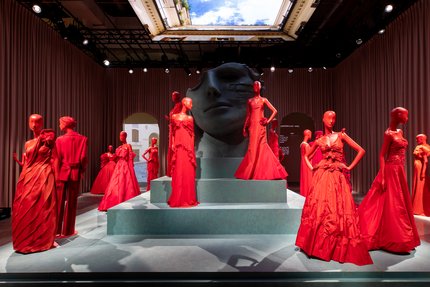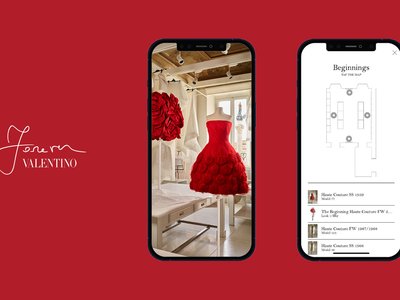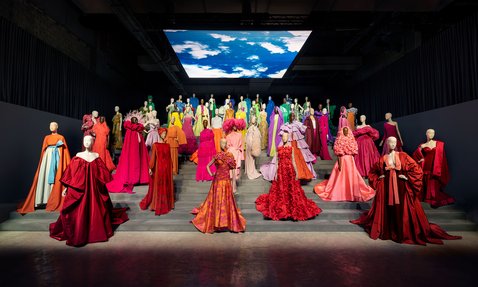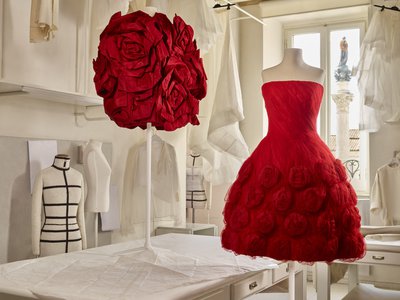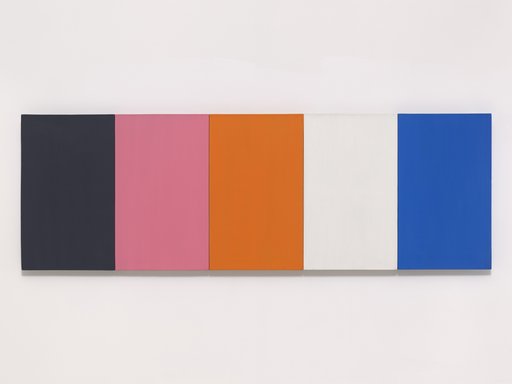Beginnings
The start of any creative process is always carte blanche—an empty page, a piece of calico, an idea. The fitting room of the Palazzo Gabrielli-Mignanelli—used by Valentino Garavani to refine his creations and still at the centre of Pierpaolo Piccioli’s creative process today—is the place where a collection begins, translating the previously imaginary into its first physical form: a toile, in white calico or muslin.
In Haute Couture, toiles take the place of two-dimensional paper dressmaking patterns—refined on the living body and later painstakingly deconstructed—providing Couture’s blueprint for creation. It is where the life of a garment commences.
This room showcases the beginnings of not only a collection but also of Valentino. It presents two important looks from two of Valentino’s earliest collections from 1967–68, sublimations of the traditional white coat or blouse Blanche, worn by the seamstresses of Couture Ateliers. They stand watch over Fiesta, the first red dress from Spring/Summer 1959. This historical piece is mirrored by its modern counterpart: a cape directly inspired by the look and youthful spirit of the original, which opened Piccioli’s Valentino The Beginning Haute Couture collection in 2022.
Des Ateliers
If the courtyard represents the physical heart of Valentino, the Ateliers are its soul. The four workrooms, which bring designers’ dreams to life, are animated by devoted seamstresses with unparalleled expertise. It is within these walls that they can create the impossible—the highest expression of fashion as an art form and a vehicle for exceptional creativity and virtuoso technique.
Artisan craft and artistic expression have been the trademarks of Haute Couture for centuries, connecting these clothes back to the Renaissance. Haute Couture excellence today focuses on two European capitals, Paris and Rome. The expert seamstresses are part of Valentino’s family, and the essence of its excellence and their personalities are as important as their vast knowledge and prowess—they imprint their characters and stories on the cloth of their creations.
This room is dedicated to the world-renowned skills of Valentino’s Ateliers and the savoir-faire that characterizes true Haute Couture. Several techniques on display have been invented entirely by the seamstresses of the Maison Valentino—passed between generations of artisans; they are unique to its creations and the distinct language of its Haute Couture.
While Haute Couture is undoubtedly a bold expression of a designer’s unbridled creativity, at Maison Valentino, it is also an essential service to a global clientele.
Haute Couture clothes are unique, made-to-order, and cut and fitted to each woman. A part of the culture of Haute Couture is that the client enters a relationship with the Atelier, evolving and adapting designs to reflect her own life. Fabrics may be changed, silhouettes altered, and designs combined, which give a couturier’s creations new vitality and a different perspective. This essential, entirely personal reflection of luxury is vital in translating Haute Couture from imagination to reality.
A quintessential dialogue between a couturier and the Ateliers becomes a conversation in which the client actively participates in a reciprocal creative dialogue. In this room, Haute Couture pieces are curated from a selection of Valentino’s most famous clients spanning its lifetime. Each one serves not only as a reflection of the codes and creativity of the Maison but also as a revelatory, intimate, emotional portrait of each woman they were created for.
Capriccio Romano
Conceived by geniuses of the Baroque, such as Giovanni Antonio Canaletto and Giovanni Battista Piranesi, the art of the capriccio turned marvellous Italian landscapes into enchanted mirages, creating many of the icons and myths that still inform the perception of Italy today. In this gallery, the notion of the capriccio inspires a treatment of Rome as a monochromatic cinematic reverie, drawing on the notable works of Italian neorealist auteurs such as Vittorio De Sica, Roberto Rossellini, Giuseppe De Santis, and Pier Paolo Pasolini, who themselves present their own fantasies of Rome.
Similarly, black and white are also key colours for Maison Valentino. By restricting the palette, emphasis is placed on volume and form, while decorative elements have a sculptural sense through the application of fabric. This room showcases allusions between the clothes of Valentino and architectures that define Rome’s identity—the Gasometer and Colosseum, modernity and classicism juxtaposed.
Four white and silver dresses from Pierpaolo Piccioli’s 2020 Of Grace And Light Valentino Haute Couture collection are shown in this gallery, underscoring the importance of cinema as a modern capriccio. As in their original presentation, the dresses are used as canvasses for the projection of films created in collaboration with Nick Knight. Fittingly, the collection was unveiled at the legendary Cinecittà film studios in Rome, a dream factory once again helping to craft the sublime.
DI.VAS
Divas have always been associated with Valentino. From its earliest years, the Maison has dressed exceptional women traditionally afforded this title from around the world. Many reside in the realm of Hollywood: figures world-renowned, internationally fêted and instantly recognised. Translated from Latin, diva means “goddess”. But today, a diva can be something different.
For Pierpaolo Piccioli—who studied literature before his career in fashion and, consequently, always expresses a keen interest in the power of language—“DI.VAs” is a wordplay, an acronym denoting “Different Values.” It describes a promotion of authenticity, progressive ideals and diversity, connecting figures across cultures—Valentino’s DI.VAs are strong, empowered, empowering, remarkable and multifaceted. Although this definition is new, it retroactively applies to the figures drawn to Valentino and Valentino to them—upholding shared inner values and beliefs.
Valentino’s DI.VAs are universally famous—but they have always used that fame as a means of communication, a way to express their belief systems and affect change in the society around them. Their fashion, in turn, has been an essential component in imparting their messages.
